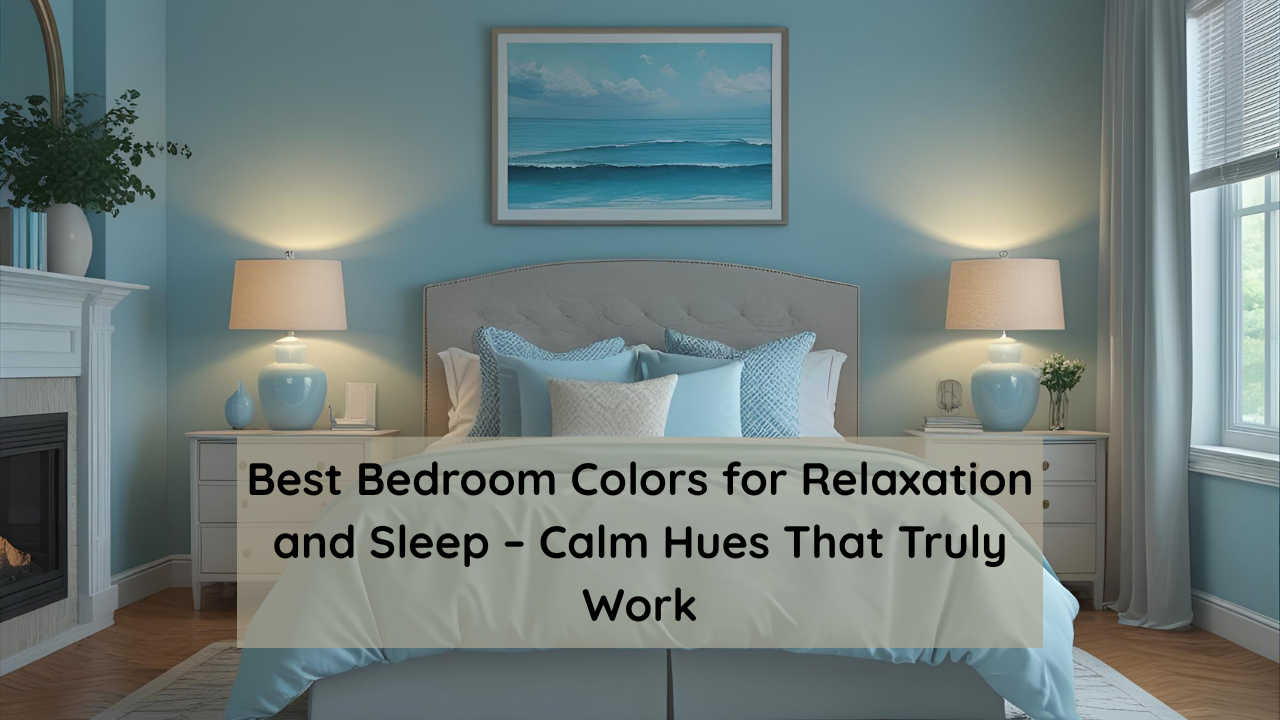Your bedroom should be your sanctuary — a place where stress melts away and deep sleep comes naturally. While lighting, textures, and furniture matter, nothing influences your mood and restfulness quite like color. Choosing the right wall color can transform your bedroom into a haven of peace, relaxation, and restorative sleep. This guide breaks down the best bedroom colors to create that ideal, serene retreat.
Overview: Top Soothing Bedroom Colors
| Wall Color | Mood Created | Sleep Benefits | Ideal Style Match | Best Paired With |
|---|---|---|---|---|
| Soft Blue | Calm & Cool | Slows heart rate, reduces stress | Coastal, Minimalist | White linens, pale wood |
| Lavender | Gentle & Feminine | Eases anxiety, soft ambiance | Boho, Romantic | Silver accents, off-white |
| Sage Green | Fresh & Organic | Connects with nature, lowers tension | Scandinavian, Zen | Linen textures, rattan |
| Light Gray | Neutral & Peaceful | Reduces overstimulation | Modern, Industrial | Dark woods, soft textiles |
| Beige & Greige | Warm & Balanced | Promotes comfort and calm | Transitional, Classic | Ivory, blush pink, bronze |
| Dusty Pink | Cozy & Delicate | Invites warmth without intensity | Shabby Chic, Soft Minimalism | White, muted gold, floral prints |
1. Soft Blue – Scientifically Soothing
Blue is one of the most recommended bedroom colors by sleep experts. Soft, pale blues mimic the sky and ocean, helping the brain relax and signaling it’s time to wind down.
Why It Works: Lowers blood pressure and heart rate.
Best For: Bedrooms with natural or soft lighting.
Pairs With: Crisp white bedding, sheer curtains, driftwood-style decor.
2. Lavender – Relaxing with a Touch of Romance
Lavender is not only visually calming but also often associated with aromatherapy and self-care. It brings elegance to the bedroom while promoting serenity.
Why It Works: Softens the room and soothes emotional stress.
Best For: Those seeking calm with a hint of personality.
Pairs With: Metallic details, light grey upholstery, vintage lighting.
3. Sage Green – Nature’s Answer to Stress
Sage green offers an earthy tranquility perfect for restful sleep. It blends the calming qualities of green with a subtle gray undertone for a modern twist.
Why It Works: Brings nature indoors, promoting groundedness.
Best For: Bedrooms with plants, wood accents, or neutral palettes.
Pairs With: Linen duvets, woven baskets, and natural wood.
4. Light Gray – Sleek Yet Sleep-Friendly
Light gray is a cool, neutral tone that doesn’t stimulate the senses, making it a great base color for those who want modern elegance without disrupting rest.
Why It Works: Neutral tones reduce visual stress and clutter.
Best For: Urban bedrooms, small apartments, minimalist styles.
Pairs With: Black metal frames, plush blankets, low lighting.
5. Beige & Greige – Timeless and Comforting
These soft, warm neutrals envelop the room in a gentle coziness. Greige (a gray-beige mix) is a perfect balance of warmth and modernity.
Why It Works: Adds quiet sophistication while encouraging calm.
Best For: Traditional or transitional design lovers.
Pairs With: Blush accents, layered bedding, brass details.
6. Dusty Pink – Warm Without Overpowering
A muted, dusty pink offers the perfect middle ground between color and calm. It can feel both modern and vintage, depending on the decor.
Why It Works: Adds emotional warmth while keeping energy low.
Best For: Romantic and feminine bedrooms.
Pairs With: Soft white furniture, warm lighting, floral artwork.
Quick Color-Matching Table
| Base Wall Color | Bedding Suggestions | Accent Options |
|---|---|---|
| Soft Blue | Crisp white | Driftwood, navy, sea glass |
| Lavender | Silver or ivory | Rose gold, dried florals |
| Sage Green | Beige or oatmeal | Bamboo, linen, pale yellow |
| Light Gray | Charcoal or taupe | Concrete, matte black, plush |
| Greige | Blush or soft pink | Brass, soft green, cream |
| Dusty Pink | White or soft gray | Gold, vintage frames, flowers |
Bedroom Paint Tips for Maximum Relaxation
- Use matte finishes to soften light reflection and reduce glare.
- Avoid bright or high-saturation colors like red, orange, or electric blue.
- Stick to cool or muted warm tones for a restful ambiance.
- Complement your wall color with natural materials like cotton, wool, and wood.
Conclusion
Color is not just a design choice — it’s a sensory tool that affects how you feel and how well you sleep. By choosing hues like soft blue, sage green, or warm greige, you set the stage for peaceful nights and rejuvenating mornings. Your bedroom should reflect comfort, calm, and your personal style. Start with the right wall color, and the rest will fall into place naturally.
FAQs
Q: What is the most relaxing wall color for sleep?
Soft blue and sage green are proven to promote deep relaxation and better sleep.
Q: Are dark bedroom colors bad for sleep?
Dark tones can work if they’re muted and paired with soft lighting and calming decor.
Q: Should I avoid bright colors in the bedroom?
Yes, overly bright or bold colors can stimulate energy and interfere with restful sleep.

